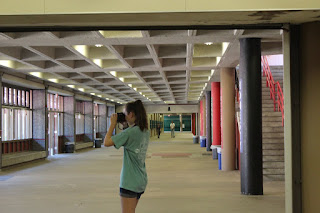B. The philosophy of newspapers like the Washington Post and the New York Times are that pictures should not be manipulated. They combat this by enforcing rules like all pictures must be turned in to prove that pictures aren't manipulated, and that that they trust the photographers to turn in unaltered pictures and they trust journalists to turn in unaltered stories.
C. I believe that not much can be done to a picture and still be ethical. Technically all alterations to a picture are unethical in the world of photojournalism.
D. I think that this picture is unethical because it places a false advertisement to the public. The University of Wisconsin is trying to break free of their racial issues by manipulating their photo and that is not okay.
E. I think this picture is least unethical because although the color manipulation was dramatic. The picture just shows a fire fighter on a ladder, it doesn't change the fire fighter or his actions in any way. The picture is pure art, and with the context I was given, I drew the conclusion that this picture was used for art and not for journalism.




























